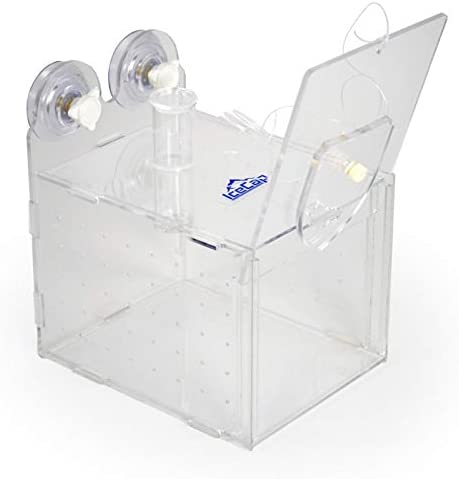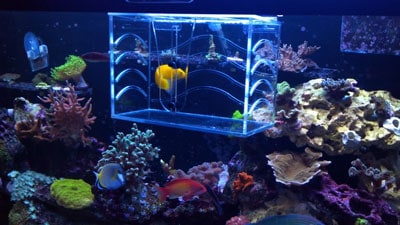There may become a time in your aquarium journey when you have to remove a fish for multiple reasons – Maybe that new fish you should not have bought is a serial killer, a fish has just taken a liking to coral, a fish has got too big or you have a fish that is just a monster!
If you cycled your saltwater aquarium with Damselfish, then I suggest you bookmark this article because one day you WILL have to remove them and they are one of the hardest fish to catch!
Not only do the ways discussed in this article work for saltwater, but any aquarium type – Freshwater, Cichlid, Discus, Brackish. Basically, ANY fish can be caught using any of the methods.
The best way to remove an unwanted fish from an aquarium is by using 1-2 nets. Herd the fish towards a net using a second net, then trap it against the glass as you raise the net out of the tank. Other alternatives are store-bought & DIY fish traps, distraction using food, or lowering the water level.
Many aquarists have tried all the methods listed below to varying degrees of success. I myself needed to go through 5-6 methods before I finally captured a beautiful Bi-Color Angel that one day decided to like the taste of my Clam’s Mantle!
Removing all the rock and water from an aquarium can be a very long and stressful process (Unless you have a 10 gallon Nano Aquarium) and should be listed as the absolute last resort. With patience, you should be able to trap not only fish, but shrimp and crabs using one of these methods.
How To Catch Fish In Aquariums Using a Net?
1. Using Two Nets
For this method, you will need at least one net of a large size. Place the large net in your dominant hand and hold it steady with one vertical edge resting against the glass inside the tank. Use your other hand with a second net to herd the target fish towards the waiting net.
With some skill and patience, you should be able to drive them in without too much issue. Once the fish is in the net, close the net entrance against the glass of the tank. Keep the net entrance against the glas as you move the net up and out of the tank.
2. Use a Large Net While Feeding
This one may require a few nights of pre-prep for it to work. Get a large net and place it in the aquarium but near the edge of the glass. Use a turkey baster to squirt food between the net and the glass.
Do this each day for 2-3 days so the fish see the net is no danger to them. Once your fish is used to eating between the net and the glass, it is just a case of the last day, move the net to the glass while they are distracted by eating and trap your target fish.
3. Mirror Distraction
This approach is very similar to food distraction but it is really useful if you have a very aggressive fish and the food doesn’t work!
Place a mirror (A hairdresser mirror with a handle makes this easy) against the outside of the glass near the top of the aquarium and wait for your target fish to begin harassing its reflection.
While it is harassing itself, move in with a large net and trap the fish between the glass. This one actually works really well!
For a nice selection of suitable nets see Here at Amazon.com
How To Catch Fish In Aquariums Using a Trap?
There are some really good fish traps that have been used to great success in both the saltwater and freshwater hobbies. Fish traps take some patience as it takes a while for the fish to get used to this foreign object being in their tank.
Fish traps need a little acclimation in the tank to work well. Place the trap in the tank empty and leave it there for 24 hours. Next day place some food at the very back of the trap and let the fish enter and eat it. Next day wait for the target fish to enter and begin eating before activating.
This is how the fish will become used to the trap and not see it as a threat. Once you have your target fish easily swimming in and out of the trap it is then time to operate it and trap them.
4. Store Bought Fish Traps
There are two fish traps that seem to get the best reviews from aquarists:
IceCap Fish Trap
The IceCap Fish Trap is a trap door-style fish trap. Food can be inserted into the feeding tube in the center of the trap and when the target fish is inside, the pull of a line removes the pin holding the door allowing the door to fall.
Trap Dimensions:
Sm Trap 150 : 8.1″ x 7.8″ x 2.9″
Md Trap 200: 9.3″ x 7.6″ x 2.2″
Lg Trap 250: 13.9″ x 9.9″ x 2.1″
It can be placed on the sand to catch invertebrates Like shrimp and Crabs or stuck to the glass using the included suction cups.
Tankmatez Bubble Fish Trap
The Tankmatez Bubble Fish Trap is the new kid on the block. Using a simple spherical trap and a magnet allows the fish to swim in and once the magnet is pulled off, the floatation device causes the trap to rapidly rise to the surface with the fish trapped inside – Super Simple!
Trap Dimension: 4″, 6″ & 8″ Diameters
Max Glass Thickness: 1″
5. How to Make a DIY Soda Bottle Fish Trap
This has been one of the go-to fish traps for decades and is usually the first trap many people will craft because it is the easiest and cheapest.
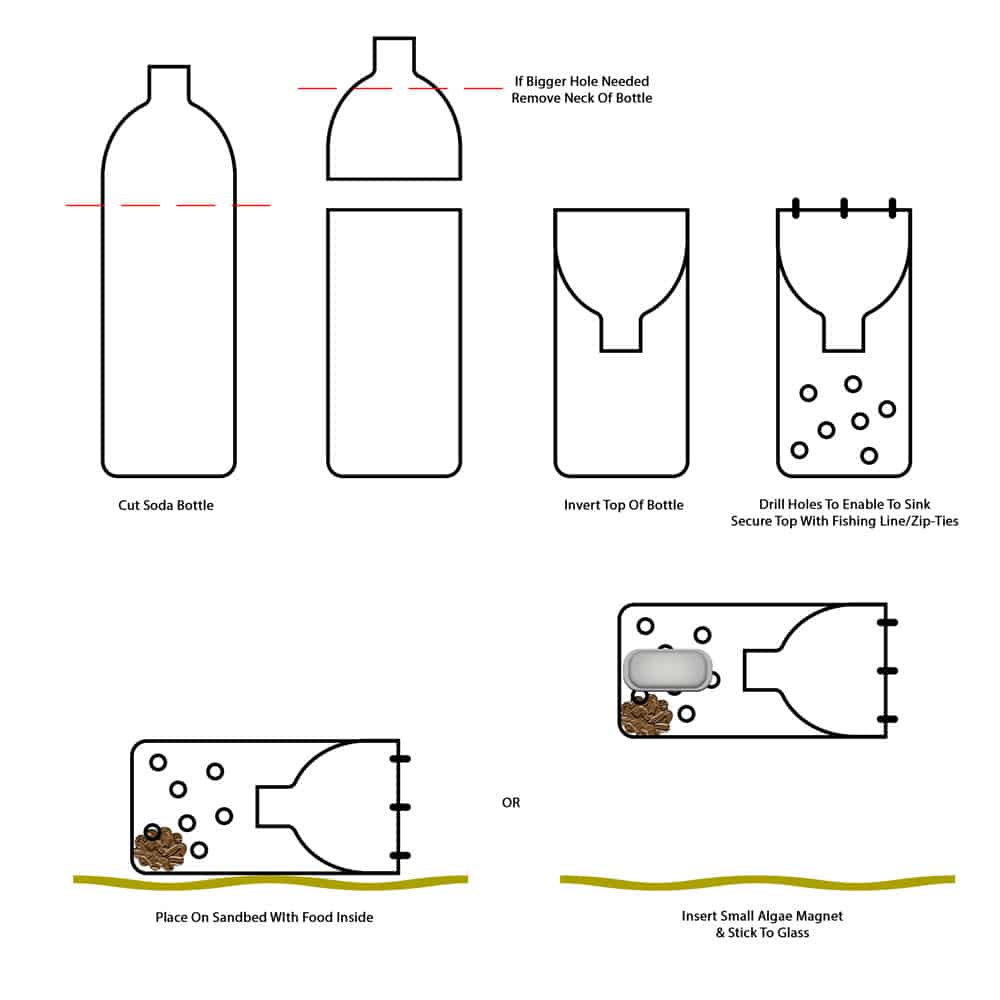
This trap works similar to crab and lobster traps. It’s easy for the fish to swim in but more difficult for the fish to swim out. Once the target fish is in the trap it is just a case of removing the trap from the tank and getting the fish.
The main problem with this trap is that it may not catch the intended fish. You may have to be patient and release a few fish before you get the target monster. Catching a few in there and then returning the wanted fish back to the aquarium is also a way to do it.
Be sure to make it easy to remove the top half of the bottle to ease returning the wrong fish back to the tank!
6. How to Make a DIY Fish Bag Trap
When you buy a fish from the store always keep the transport bags as they come in handy as they can make a good fish trap. Similar to the bottle trick, this one requires some patience, and the water flow in the tank turned down for it to work.
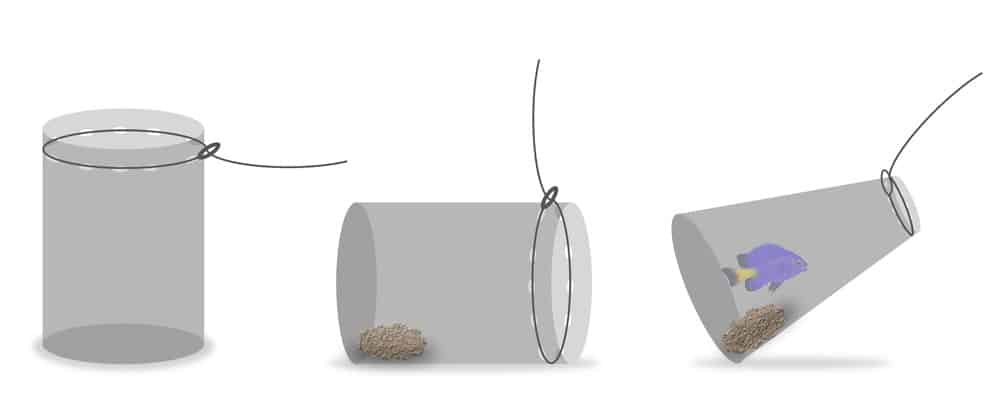
When the fish enters the bag you can pull up on the fishing line and the top of the bag will close up. Don’t be too quick to do this as it could tear the bag.
If you find the bag is not staying open you could secure the bag to the glass using an algae magnet with the flow going into the bag to keep it open.
7. How to Make a DIY Egg Crate Fish Trap
This was the trap I used to catch my Bi-Color Angel. Crafting this trap allows you to make a trap to suit any size fish.
Grab yourself a sheet of Egg-Crate from the hardware store – It’s usually in the Suspended Ceiling section. Using side cutters, cut 4 rectangular pieces the same size and secure together with Zip-Ties to make a tube.
Cut 2 end squares and secure one to one end of the Egg-Crate Tube. Secure the other square to the opposite end of the tube using 2 loosely tightened zip-ties to make a door.
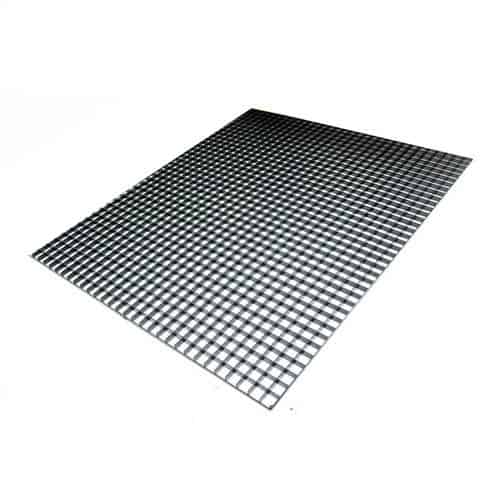
Secure fishing line to the door and run it through one of the squares so when you pull it, it closes the door towards the egg crate tube.
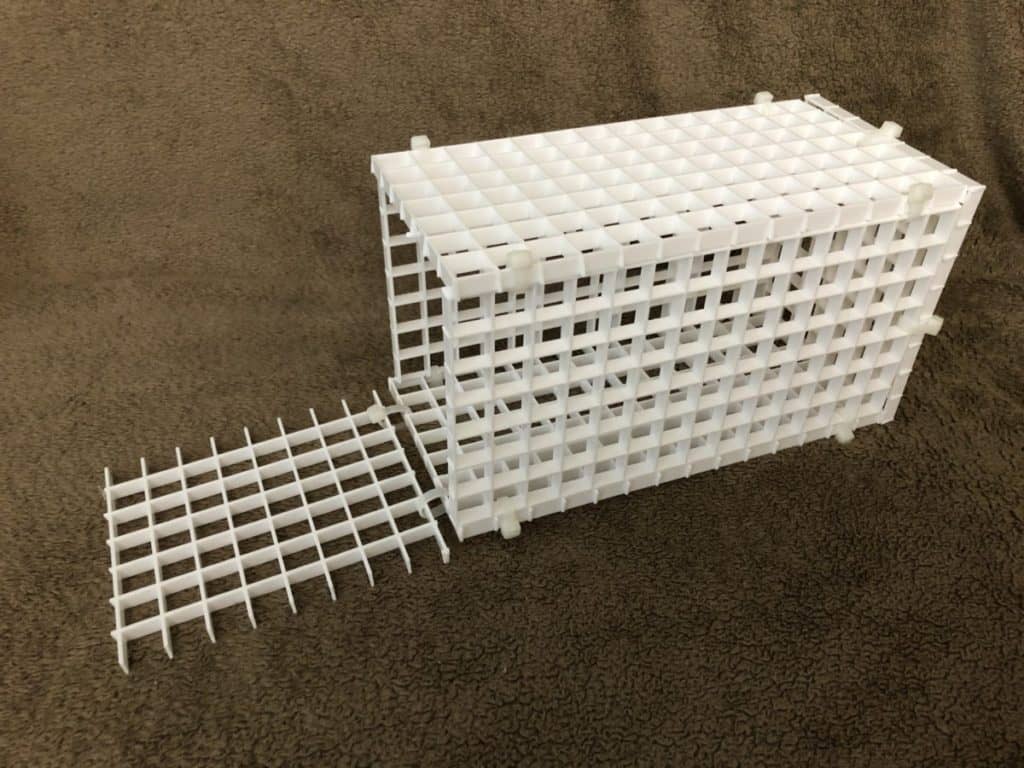
Lay the egg-crate trap on the sand with the door open and resting on the sand. Once the fish swims in, pull on the fishing line, it closes the door like a medieval drawbridge and you have your fish.
8. Glass Jar
This one is more for catching that elusive crab that is destroying your Zoa population or taken a liking to snail meat!
Crabs are unable to climb up glass so by placing a mason jar into the sand with the opening angled upward, with some food in the bottom just before lights out, you may well find your critter in the bottom of the jar by morning.
If your sand is not that deep, it’s a good option to lean the mason jar against your rock so the crab has a way to get into the jar, but then is unable to get enough grip to climb back out.
By doing this at lights out chances are the food will stay in there without the fish taking it or It may be a method you have to try an hour after lights out so all your fish are sleeping/hiding.
How To Catch Fish In Aquariums at Night?
These are going to require pulling some later nighters if your tank lights do not shut off until 11pm! Usually within 1 hour of your tank lights going off and the room has been dark, these will be quite effective methods!
9. Scooping With a Net While Sleeping
It is well known among divers that night dive in the ocean that the reef is a very quiet place. Many fish sleep in their favorite spots and are very lethargic when you come wandering around with your flashlight.
If your target fish likes to sleep out in an accessible place it is as simple as shining a flashlight on them and they freeze. Get your net and scoop them up. It is that simple!
Fish are very easy to catch when they have been asleep! This is of course if they sleep out in the open – If they sleep in a hole, now what…
10. Startle From Sleeping Hole
This method is going to require a few nights of investigation with a red flashlight. The red light does not seem to be seen by fish so it allows you to watch where everyone goes when the lights go off.
If your target fish sleeps in a hole and it’s one you can access then here is what to do:
- Fill a syringe with aquarium water
- Place a length of airline hose on the end of the syringe
- Place the other end of the hose into the fishes’ hiding hole
- Place a large net over the hole
- Squirt the water quickly into the hole – Fish should come darting out straight into the net
- Your fish should still be lethargic allowing you to capture them
- For the rest of the evening you could just keep them in an isolated fish container like this one below, then deal with them the next day:
Other Methods of Catching Fish in Aquariums
These last few methods don’t really fall into any of the categories above but could be the one trick left for you to try before you completely lose your mind!
11. Fishing Line & Hook
Yep, it’s time to get fishin’! By using a small barbless hook some fishing line and some meaty portions of your monster’s favorite food you can catch them just like you were on the lake pulling out Bass!
It can take a little bit of jigging around to keep the other fish from the meaty morsel, but a bit of food in a turkey baster can help to draw the crowd while you focus on placing the hooked bait right in front of your target fish.
Many an aquarist have tried for weeks to get a fish and then within 15 seconds of the hook hitting the water, their elusive fish is on the end!
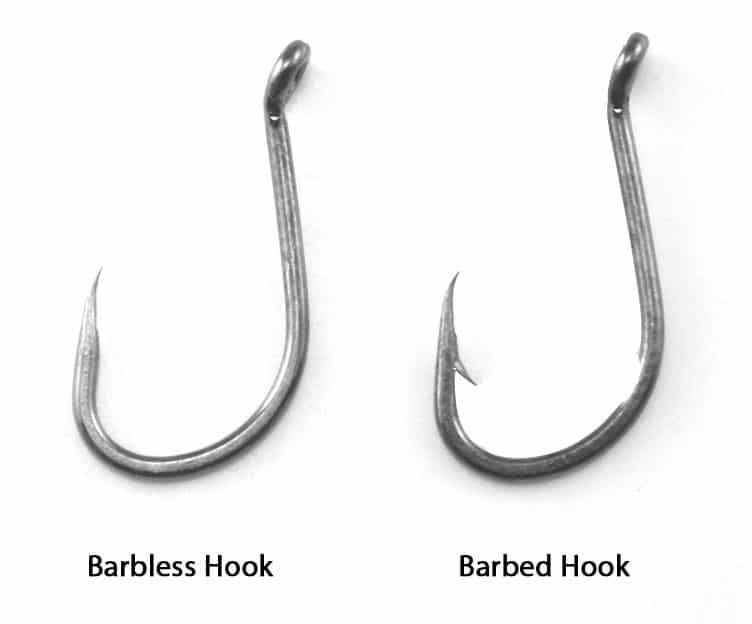
Be sure to match the size of the hook to the fish’s mouth. You will be able to find a vast selection at any outdoor store, Walmart or even the gas station!
12. Egg Crate Tank Divider
When you are starting to run out of ideas there is one last thing to try before we hit method #12 and that is to try and reduce the amount of space your target fish has to swim in.
Using the egg crate we mentioned earlier, you can easily cut out a piece that will fit in your tank with a cutout to fit over your rock, thus creating a wall.
Get the fish feeding at one end of the tank then slide in your egg crate wall and have a helper hold it in place while you now try and capture the fish using two nets. Having less space to swim will help incredibly!
Using a small net to drive the fish toward a larger net usually works too, but this method can be tough with limited space. If you need to build a second egg crate wall to half off the area you have already segregated, then this may help too.
13. Removing Water
And finally, the worst method of them all and one that I hope none of you have to go through, especially if you have a large aquarium with hundreds of pounds of rock, but hopefully no corals yet!
By removing your rock and draining 3/4 of your water into some Rubbermaid Brute trashcans you now have an open playing field to chase and catch that monster.
Once caught, be sure to put your rock back in and then add your water back as soon as you can. It is a good idea to place a heater in the trashcans to keep your water warm, also place a heater flat on the sandbed to keep the water in your aquarium warm too. Make sure the rock stays damp to avoid the bacteria on that drying out and dying too.
The last thing you need after going through all this is the bacteria on your rock or sand to die, then you have to go through a miniature cycle again.
To Finish
I really hope that you never need some of these methods because trying to catch a fish can be one of the most frustrating things you can do in your entire life!
To hopefully avoid this hassle though the best defense is to research every fish you intend to buy. See what they may be prone to doing, what species of fish they may fight with, if they are aggressive and when you should add them in your stocking plan.
10 minutes of simple research can save you hours of hair-pulling torture!
Further Reading
If you found this article helpful please be sure to check out some of our others listed here:

